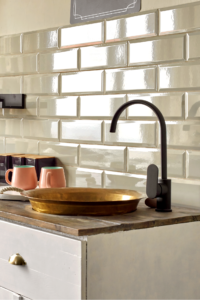Brass items can be found in many households. Cleaning them is not too complicated as long as you know how to do it properly. You can maintain all brass objects clean and shiny with a bit of elbow grease and some common household products you probably already have at home.
Brass is used for a number of household items – plates, door knobs and knockers, bathroom fixtures, furniture, decorative ornaments, and even kitchen utensils. This relatively inexpensive, corrosion-resistant metal is made from zinc and copper and gives a warm shine and burnished glow to pieces. Its bright, gold colour has made it a favourite material for home decor and design. However, like any other metal, brass can become dull and tarnished over time. Fortunately, keeping your brass items tarnish-free and shiny is not complicated at all. In fact, you will be surprised by how many effective brass-cleaning products can be found in your kitchen.
Before you attempt the methods we will talk about in this article, you should always determine if the item you are about to clean is indeed brass. Even if it looks like solid brass, it may be in fact, brass-plated steel, zinc, or cast iron. If you are not sure about a piece, the easiest way to check is by using a magnet. Hold one close to the item and see if it sticks. Magnets will not stick to solid brass items. If the item you are about to clean is brass-plated, you can use hot soapy water but keep in mind that harsh rubbing may strip the brass plating so proceed with caution.You can also always turn to cleaning professionals if you think you can’t handle it yourself.
There are many ways in which you can clean your solid brass items and maintain them nice and shiny for longer. Your approach should depend on the amount of dust, dirt, grime, and tarnish that has built up on the surface of the item. Here are a few tips and techniques:
Always start with hot, soapy water and a microfiber cleaning cloth. First, go over the whole surface of the item with the cleaning cloth. You can use a clean toothbrush to reach any creviced and hard-to-reach places. Rinse well with hot water and dry thoroughly.
If there are any tougher stains or grime that need to be removed, it is time to pull out the ketchup from your kitchen cupboard. You can also use tomato sauce or tomato paste. All you have to do is apply a thin coat of the product on the surface of the brass item and rub it in with a cloth. Let it sit for an hour or two, then use hot soapy water to rinse the piece. Use a clean soft cloth to thoroughly dry the whole surface.
Another option is to make your own cleaning paste. Mix equal parts salt, flour, and white vinegar in a small bowl. Apply the paste in the same way described above and let it sit for an hour or two. Rinse with warm water and buff the piece dry with a soft cloth.
An alternative homemade solution for cleaning brass would be salt and lemon. You need one lemon. Cut it in half and remove all the seeds. Coat the cut half of the lemon with table salt and rub it over the surface of the brass item. Re-coat the lemon half if needed. Once you have covered the whole brass item, buff the surface to a shine with a clean, dry cloth.
If you don’t like those solutions or don’t have any of the ingredients, you can also make a paste using two parts cream of tartar powder to one part lemon juice. Rub that paste all over the brass item, let it sit for half an hour, rinse with warm water and buff dry with a soft cloth.
You can always choose to use a commercial metal cleaner. They can be effective for cleaning brass, and can easily be found in supermarkets, convenience stores, and hardware stores. Always check the product packaging to find out if the product is suitable for brass or not.
When cleaning brass, there are some things you should avoid doing in order to prevent damage of any kind. Here are some of them:
Avoid using steel wool, abrasive sponges, or hard-bristled or metal brushes. Those will scratch the surface of the brass and cause permanent damage.
To prevent tarnish, you can apply a thin coat of linseed or mineral oil on a clean brass item using a soft terry towel.
Many brass pieces are protected with a lacquer finish and should only be cleaned with hot soapy water. If such pieces are heavily tarnished, you will need to remove the lacquer, clean and polish the item using one of the methods listed above, then re-lacquer the item.
You should avoid excessive touching. Body oils can cause more tarnish.
Regular dusting and cleaning with a microfiber cloth will prevent tarnish and reduce the amount of dust and dirt that accumulate on your brass piece, keeping it clean and shiny for longer.

